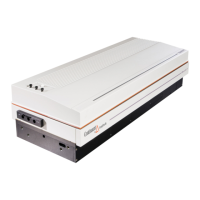13
1.3.3 Polarizer Housing Window (not shown)
A window to allow the introduction of the seed laser beam into the host laser resonator is
installed in the port in the Polarizer Housing, replacing the plug and 1.06 µm absorbing glass that
normally reside there.
1.3.4 Internal Cooling Water Temperature Stabilization
A combination temperature sensor and proportional valve device should be installed in host
lasers configured for injection seeding. Temperature stabilizing the internal cooling water maintains
the Nd:YAG oscillator rod at the same average temperature as the NPRO seed laser, fixing its gain
curve envelope in frequency. The device employed typically regulates the flow of external cooling
in the host laser heat exchangers so that the internal cooling water maintains a constant temperature.
Also, a pressure sensor should be included with the cooling water modification to ensure the
presence of external cooling water pressure.
1.3.5 Q-Switch Drive Modification
For some host lasers it will be necessary to slow the risetime of the high voltage applied to the
Pockels cell for Q-switching. The risetime for the waveform should be 30 nsec. This slow opening
of the Q-switch allows a smooth pulse to build up out of the cw seed laser emission.
1.3.6 Elimination of All Secondary Etalon Effects
Special attention must be given to the installation of all optical components within the host laser
resonator to ensure there are no unwanted reflections from any optical surfaces. Even the reflection
from an anti-reflection coated surface, if directly on axis, is enough to form a weak etalon which can
discriminate against the seed laser frequency in an indeterminate fashion. Such etalon effects can be
significant enough to cause a noticeable impact on injection seeding.

